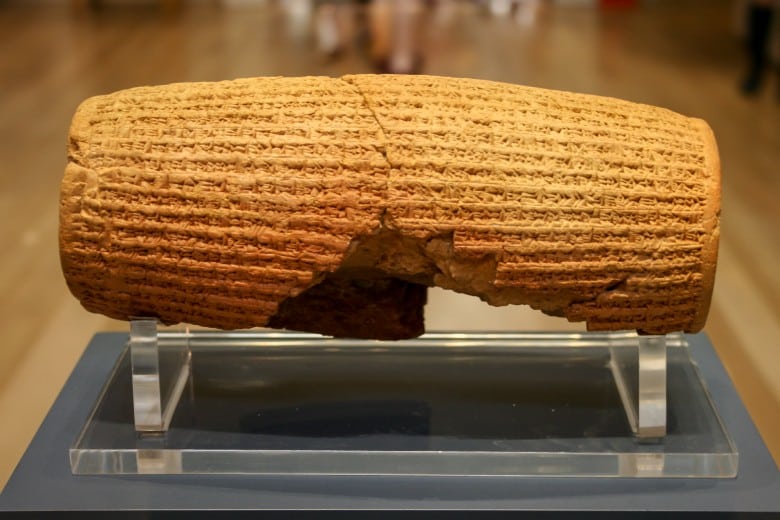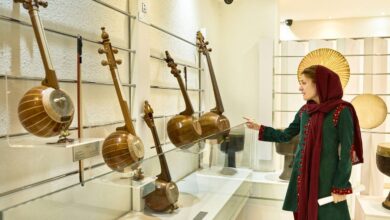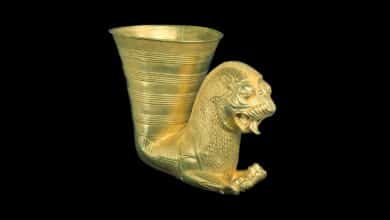The Cyrus Cylinder: A Symbol of Tolerance and Leadership
Cyrus Cylinder: Foundation of Cultural Harmony and Governance

The Cyrus Cylinder, displayed in the British Museum, is an unassuming yet profoundly significant artifact that symbolizes cultural tolerance, political ingenuity, and effective leadership. Created around 539 BCE after the conquest of Babylon by Cyrus the Great, the cylinder represents a blend of administrative genius and respect for diverse cultural and religious traditions.
| Cyrus CylinderAncient clay cylinderThe Cyrus Cylinder is an ancient clay cylinder inscribed with an Achaemenid royal inscription in Akkadian cuneiform script, created around 539–538 BC in the name of the Persian king Cyrus the Great. | |
| Material | Baked clay |
| Size | 21.9 cm x 10 cm (maximum) |
| Writing | Akkadian cuneiform script |
| Created | About 539–538 BC |
| Present location | British Museum, London |
Its importance resonates today as a document that embodies early notions of governance that integrate cultural respect and pragmatism.
Contents
Historical Context and Discovery
The Cyrus Cylinder is a product of the Achaemenid Empire and was unearthed in 1879 by Hormuzd Rassam, an Assyro-British archaeologist conducting excavations funded by the British Museum. The clay cylinder, measuring approximately 22 cm, contains an inscription in Akkadian cuneiform that outlines Cyrus’s policies after his conquest of Babylon.

The content of the cylinder portrays Cyrus as a liberator, specifically chosen by the Babylonian god Marduk to rule justly and restore order. It details his lineage, efforts to restore temples, and the return of displaced peoples to their homelands—a revolutionary move during an era marked by violent conquests and oppressive rulers.
Map of Babylon showing the site where Hormuzd Rassam’s team unearthed the Cyrus Cylinder in the Tell Amran-ibn-Ali mound, beneath the remains of the Esagila temple.
Cyrus is juxtaposed against his predecessor, Nabonidus, who is depicted as having deviated from proper religious practices, having neglected the worship of Marduk, and having imposed harsh policies on the populace.

This contrast was instrumental in legitimizing Cyrus’s rule in the eyes of the Babylonian population, who would have been familiar with the idea of divine approval for rulers. This strategy was not merely propaganda but also an effort to instill a new vision of governance that focused on stability through respect for cultural and religious identities.
The Cyrus Cylinder‘s discovery coincided with a broader Western fascination with the ancient Near East, fueled both by biblical studies and the desire to uncover the origins of human civilization. Its inscription, celebrated as one of the most consequential archaeological finds of the 19th century, provided critical insights into Achaemenid policies, the role of propaganda, and the interplay between political power and religious legitimacy during this pivotal period of history.

Cyrus Cylinder Translation
The surviving inscription on the Cyrus Cylinder consists of 45 lines of text written in Akkadian cuneiform script. The first 35 lines are on fragment “A” and the remainder are on fragment “B”. A number of lines at the start and end of the text are too badly damaged for more than a few words to be legible.
The text is written in an extremely formulaic style that can be divided into six distinct parts:
Fifteen horizontal lines of text written in Akkadian cuneiform script.
Extract from the Cyrus Cylinder (lines 15–21), giving the genealogy of Cyrus and an account of his capture of Babylon in 539 BC (E. A. Wallis Budge, 1884).
Lines 1–19: an introduction reviling Nabonidus, the previous king of Babylon, and associating Cyrus with the god Marduk;
Lines 20–22: detailing Cyrus’s royal titles and genealogy, and his peaceful entry to Babylon;
Lines 22–34: a commendation of Cyrus’s policy of restoring Babylon;
Lines 34–35: a prayer to Marduk on behalf of Cyrus and his son Cambyses;
Lines 36–37: a declaration that Cyrus has enabled the people to live in peace and has increased the offerings made to the gods;
Lines 38–45: details of the building activities ordered by Cyrus in
Babylon.
Detail image of text
Sample detail image showing cuneiform script.
The beginning of the text is partly broken; the surviving content reprimands the character of the deposed Babylonian king Nabonidus. It lists his alleged crimes, charging him with the desecration of the temples of the gods and the imposition of forced labor upon the populace. According to the proclamation, as a result of these offenses, the god Marduk abandoned Babylon and sought a more righteous king. Marduk called forth Cyrus to enter Babylon and become its new ruler.
In [Nabonidus’s] mind, reverential fear of Marduk, king of the gods, came to an end. He did yet more evil to his city every day; … his [people …………….…], he brought ruin on them all by a yoke without relief … [Marduk] inspected and checked all the countries, seeking for the upright king of his choice. He took the hand of Cyrus, king of the city of Anshan, and called him by his name, proclaiming him aloud for the kingship over all of everything.
Midway through the text, the writer switches to a first-person narrative in the voice of Cyrus, addressing the reader directly. A list of his titles is given (in a Mesopotamian rather than Persian style): “I am Cyrus, king of the world, great king, powerful king, king of Babylon, king of Sumer and Akkad, king of the four quarters [of the earth], son of Cambyses, great king, king of Anshan, descendant of Teispes, great king, king of Anshan, the perpetual seed of kingship, whose reign Bel [Marduk] and Nebo love, and with whose kingship, to their joy, they concern themselves.” He describes the pious deeds he performed after his conquest: he restored peace to Babylon and the other cities sacred to Marduk, freeing their inhabitants from their “yoke”, and he “brought relief to their dilapidated housing (thus) putting an end to their (main) complaints”.He repaired the ruined temples in the cities he conquered, restored their cults, and returned their sacred images as well as their former inhabitants which Nabonidus had taken to Babylon. Near the end of the inscription Cyrus highlights his restoration of Babylon’s city wall, saying: “I saw within it an inscription of Ashurbanipal, a king who preceded me.” The remainder is missing but presumably describes Cyrus’s rededication of the gateway mentioned.
A partial transcription by F. H. Weissbach in 1911 was supplanted by a much more complete transcription after the identification of the “B” fragment; this is now available in German and in English. Several editions of the full text of the Cyrus Cylinder are available online, incorporating both “A” and “B” fragments.
Structure and Purpose of the Cylinder

The Cyrus Cylinder consists of distinct sections that serve specific rhetorical purposes. The initial part of the inscription legitimizes Cyrus’s takeover by emphasizing his endorsement by Marduk.
Nabonidus is denounced as having neglected the duties of a righteous king—such as maintaining the worship of Marduk and caring for his people.
The subsequent section, written in the first person, presents Cyrus as a pious ruler who respects local religions, rebuilds temples, and restores the displaced populations.
These inscriptions also served a ceremonial function as foundation deposits, which were common in Mesopotamian traditions. Foundation deposits were used to symbolically dedicate new constructions to the gods and signify the divine legitimacy of the ruler responsible for the building.
The cylinder was buried beneath Babylon’s walls as an act of consecration and a declaration of Cyrus’s divinely approved leadership.
The language and stylistic choices reflect a deliberate attempt to connect Cyrus with past rulers, particularly those of the Neo-Assyrian and Babylonian eras.
This continuity would have strengthened Cyrus’s position among his new subjects, who valued tradition and divine favor in governance.
The cylinder also uses an archaic stylistic form, drawing on earlier conventions from Neo-Assyrian and Babylonian texts, which suggests that the artisans and scribes who crafted the artifact intended to evoke the legitimacy of past great rulers. This connection to historical traditions provided a powerful sense of continuity, which was critical to winning the hearts of the conquered population and ensuring a stable transition of power.
The Cyrus Cylinder’s Influence on Governance

The Cyrus Cylinder has often been referred to as an early declaration of human rights, emphasizing tolerance and coexistence. It records Cyrus’s decree allowing various displaced peoples—including the Jews who had been exiled by the Babylonians—to return to their homelands and rebuild their temples. This policy of repatriation, echoed in the Hebrew Bible‘s Book of Ezra, underlines Cyrus’s support for religious freedom and restoration.
While the policy appears altruistic, it also had significant strategic value. By enabling displaced communities to return to their native lands and supporting the restoration of local temples, Cyrus effectively gained the loyalty of these groups and stabilized the newly acquired territories.

This pragmatic approach was a stark contrast to the often coercive and homogenizing strategies of previous empires, which frequently led to unrest and rebellion. By respecting the traditions and religious beliefs of his subjects, Cyrus was able to create a more integrated and harmonious empire, one that laid the groundwork for the success of the Achaemenid Dynasty.
Scholars, including those at the British Museum, have often compared the Cyrus Cylinder to the Universal Declaration of Human Rights. While this analogy may be anachronistic, it underscores the progressive nature of Cyrus’s policies.
The cylinder is better understood as a sophisticated tool of imperial propaganda—a declaration aimed at establishing Cyrus’s reign as being sanctioned by the gods and characterized by just governance. This enlightened approach to rulership, grounded in respect for diversity, distinguished Cyrus from other ancient conquerors and resonated with his subjects.
The Cyrus Cylinder is thus a precursor to the concepts of governance that promote cultural plurality and tolerance. However, it is essential to view this policy through the lens of ancient pragmatism.
The concept of universal human rights, as understood today, was absent in antiquity. Cyrus was primarily motivated by the desire for political stability and the effective management of a vast empire.
Despite this, the symbolic resonance of the Cyrus Cylinder continues to inspire, representing ideals of tolerance and respect that transcend its original historical context.
Modern-Day Significance and Cultural Legacy

The Cyrus Cylinder has traveled far beyond its origins in Babylon, becoming a powerful cultural symbol. In 1971, during the 2,500th anniversary of the Persian Empire, it was displayed in Tehran and described by Shah Mohammad Reza Pahlavi as the “first charter of human rights.” While this description has faced criticism for exaggeration, the cylinder remains a significant cultural icon for Iranians, symbolizing a time when Persian leadership was associated with justice and respect for diversity.
In 2010, the Cyrus Cylinder was exhibited in the United States, celebrated as a “document of freedom” and a testament to values of tolerance and justice.
Such exhibitions have reinforced its status as a global cultural artifact, contributing to international understanding and goodwill. The cylinder’s messages of cultural harmony and enlightened governance resonate particularly strongly in today’s increasingly polarized world, serving as a reminder of the potential for inclusive leadership.
The Cyrus Cylinder also plays a crucial role in ongoing discussions around cultural heritage and national identity. For Iranians, it is not merely a historical relic but an emblem of cultural pride and resilience. The emphasis on respecting cultural differences and local traditions aligns with modern values of multiculturalism and coexistence, making the cylinder a potent symbol of what governance can achieve when it respects diversity and fosters unity.
Artistic and Literary Significance

Beyond its political implications, the Cyrus Cylinder highlights the Achaemenid Empire’s sophisticated artistic and literary heritage. Its careful construction, the choice of Akkadian cuneiform, and the highly structured language all reflect the significant expertise of the artisans and scribes involved. The cylinder’s shape—a barrel-like form inscribed with intricate proclamations—was characteristic of royal decrees, used to convey authority and divine sanction.
The Cyrus Cylinder serves as a testament to Iran’s cultural heritage, encompassing not just political history but also the continuation of artistic traditions. The creation of such an artifact required both technical skill and a deep understanding of the language of power.
Artisans and scribes were key participants in statecraft, using their expertise to create works that legitimized and immortalized the authority of rulers.
The influence of the Cyrus Cylinder can be seen in subsequent empires and rulerships, inspiring approaches that use cultural and religious tolerance as a foundation for governance. Its themes resonate throughout history, from Roman edicts promoting local autonomy to modern declarations of civil rights.
As an artistic artifact, the Cyrus Cylinder provides insight into the ceremonial aspects of Achaemenid rule, where art and text were combined to convey messages of legitimacy and divine favor.
Visiting the Cyrus Cylinder

For those interested in viewing this important piece of history, the Cyrus Cylinder is housed in the British Museum’s Middle East collection. Here are some practical tips for planning your visit:
- Opening Hours: Check the British Museum’s official website for current hours and schedules.
- Best Times to Visit: To avoid large crowds, consider visiting during early mornings or weekdays.
- Cultural Etiquette: Photography is allowed, but please refrain from using flash to help preserve the artifact.
- Interactive Displays: The museum also offers interactive exhibits and digital guides, which provide a richer understanding of the Cyrus Cylinder and its context.
Conclusion
The Cyrus Cylinder transcends its physical form, encapsulating a vision of governance that values inclusivity, respect, and compassion. As a testament to Cyrus the Great’s legacy, it continues to inspire debates on governance, cultural cohesion, and human rights. It is not just an artifact of ancient history; it is a symbol of leadership that can guide us even today.
The Cyrus Cylinder’s message—respect for cultural diversity and the pursuit of just leadership—is particularly relevant in our contemporary world, fraught with division and intolerance. It stands as a reminder that effective governance can and should prioritize the welfare of all people, transcending cultural and national boundaries. Its enduring legacy continues to be a source of inspiration, underscoring the importance of unity and the shared values that bind humanity together.
References
The following references include a curated list of scholarly books, museum collections, and academic articles that informed the article’s exploration of the Cyrus Cylinder. These sources provide insights into its historical significance, cultural impact, and enduring legacy.
- Axworthy, M. (2007). Iran: Empire of the mind: A history from Zoroaster to the present day. Penguin Books.
- British Museum. (n.d.). The Cyrus Cylinder. Retrieved from https://www.britishmuseum.org
- Brosius, M. (2021). A history of ancient Persia: The Achaemenid Empire. Wiley-Blackwell.
- Curtis, J., Sandmann, I. S., & Stanley, T. (2021). Epic Iran: 5000 years of culture. V&A Publishing.
- Encyclopaedia Iranica. (n.d.). Cyrus IV: The Cyrus Cylinder. Retrieved from https://iranicaonline.org
- Lonely Planet Publications. (2017). Iran. Lonely Planet Publications.
- Simonin, A. (2012). The Cyrus Cylinder. World History Encyclopedia. Retrieved from https://www.worldhistory.org
- Smithsonian Institution. (1964). 7000 years of Iranian art. Smithsonian Institution.
- Wikipedia contributors. (2024). Cyrus Cylinder. In Wikipedia. Retrieved from https://en.wikipedia.org/wiki/Cyrus_Cylinder
- Duguid, N. (2016). Taste of Persia: A cook’s travels through Armenia, Azerbaijan, Georgia, Iran, and Kurdistan. Artisan Books.
Read More






